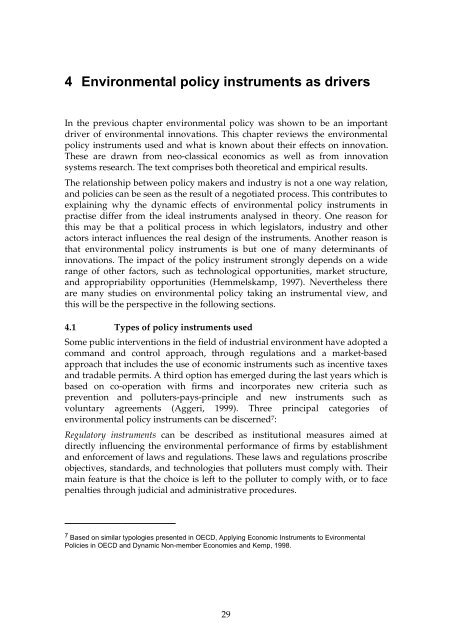Drivers of environmental innovation - Vinnova
Drivers of environmental innovation - Vinnova
Drivers of environmental innovation - Vinnova
You also want an ePaper? Increase the reach of your titles
YUMPU automatically turns print PDFs into web optimized ePapers that Google loves.
4 Environmental policy instruments as drivers<br />
In the previous chapter <strong>environmental</strong> policy was shown to be an important<br />
driver <strong>of</strong> <strong>environmental</strong> <strong>innovation</strong>s. This chapter reviews the <strong>environmental</strong><br />
policy instruments used and what is known about their effects on <strong>innovation</strong>.<br />
These are drawn from neo-classical economics as well as from <strong>innovation</strong><br />
systems research. The text comprises both theoretical and empirical results.<br />
The relationship between policy makers and industry is not a one way relation,<br />
and policies can be seen as the result <strong>of</strong> a negotiated process. This contributes to<br />
explaining why the dynamic effects <strong>of</strong> <strong>environmental</strong> policy instruments in<br />
practise differ from the ideal instruments analysed in theory. One reason for<br />
this may be that a political process in which legislators, industry and other<br />
actors interact influences the real design <strong>of</strong> the instruments. Another reason is<br />
that <strong>environmental</strong> policy instruments is but one <strong>of</strong> many determinants <strong>of</strong><br />
<strong>innovation</strong>s. The impact <strong>of</strong> the policy instrument strongly depends on a wide<br />
range <strong>of</strong> other factors, such as technological opportunities, market structure,<br />
and appropriability opportunities (Hemmelskamp, 1997). Nevertheless there<br />
are many studies on <strong>environmental</strong> policy taking an instrumental view, and<br />
this will be the perspective in the following sections.<br />
4.1 Types <strong>of</strong> policy instruments used<br />
Some public interventions in the field <strong>of</strong> industrial environment have adopted a<br />
command and control approach, through regulations and a market-based<br />
approach that includes the use <strong>of</strong> economic instruments such as incentive taxes<br />
and tradable permits. A third option has emerged during the last years which is<br />
based on co-operation with firms and incorporates new criteria such as<br />
prevention and polluters-pays-principle and new instruments such as<br />
voluntary agreements (Aggeri, 1999). Three principal categories <strong>of</strong><br />
<strong>environmental</strong> policy instruments can be discerned 7 :<br />
Regulatory instruments can be described as institutional measures aimed at<br />
directly influencing the <strong>environmental</strong> performance <strong>of</strong> firms by establishment<br />
and enforcement <strong>of</strong> laws and regulations. These laws and regulations proscribe<br />
objectives, standards, and technologies that polluters must comply with. Their<br />
main feature is that the choice is left to the polluter to comply with, or to face<br />
penalties through judicial and administrative procedures.<br />
7 Based on similar typologies presented in OECD, Applying Economic Instruments to Evironmental<br />
Policies in OECD and Dynamic Non-member Economies and Kemp, 1998.<br />
29

















